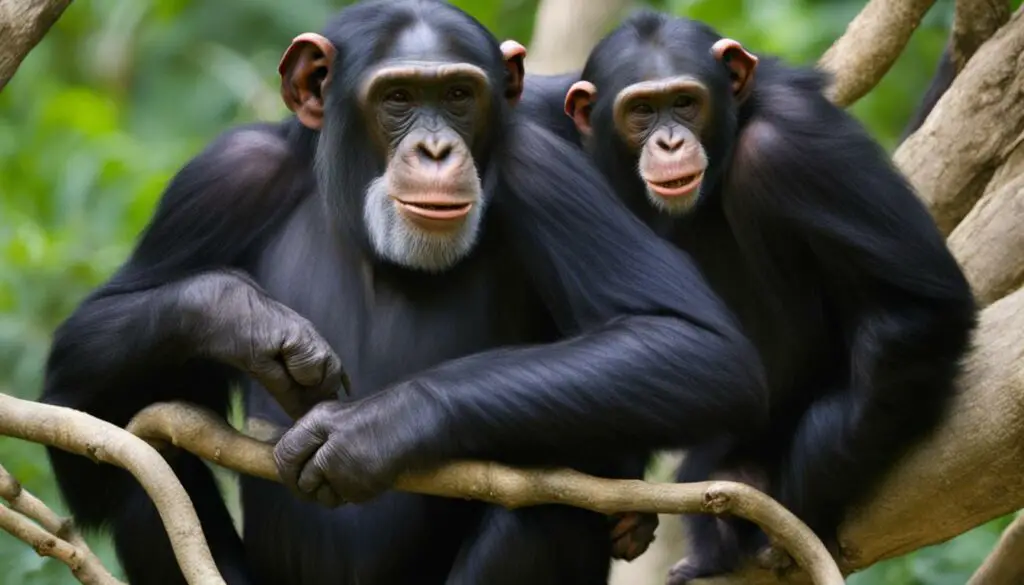Chimpanzees, our closest biological relatives, have a complex system of communication that involves both vocalizations and non-verbal gestures. They use a variety of sounds and methods to convey messages and interact with each other.
In terms of vocalizations, chimpanzees make use of various sounds such as grunts, hoots, screeches, and whimpers. These vocalizations can express different emotions such as anger or fear. Researchers have conducted extensive studies to understand the vocal repertoire of chimpanzees and their ability to communicate effectively.
Vocalizations of Chimpanzees
Chimpanzees, our closest relatives in the animal kingdom, have a fascinating vocal repertoire that they use for communication. These intelligent creatures express themselves through a range of vocalizations, including grunts, hoots, screeches, and whimpers. Each of these sounds conveys different emotions and messages, allowing chimpanzees to effectively interact with one another.
Researchers have dedicated extensive studies and research to better understand the vocal abilities of chimpanzees. By analyzing their vocal repertoire, scientists can gain valuable insights into the complexity of chimpanzee communication. These studies provide a deeper understanding of how chimpanzees use vocalizations to express their needs, emotions, and intentions within their social groups.
| Vocalization Type | Meaning/Emotion |
|---|---|
| Grunts | Expressing contentment or satisfaction |
| Hoots | Signaling their presence, indicating calmness |
| Screeches | Expressing distress, fear, or aggression |
| Whimpers | Indicating submission or a request for assistance |
The vocal repertoire of chimpanzees provides crucial insights into their cognitive and emotional capabilities. It showcases their ability to communicate complex messages and maintain social relationships within their communities. Understanding their vocalizations is not only fascinating but also helps us comprehend the evolutionary roots of human communication.
Non-verbal communication methods of chimpanzees
Chimpanzees, like humans, rely on more than just vocalizations to communicate. They possess a rich repertoire of gestures and body language that allows them to convey messages and maintain social interactions within their groups. These non-verbal cues play a crucial role in chimpanzee communication.
Chimpanzees use a wide range of gestures to express different emotions, intentions, and desires. For example, they may extend their arm to request something or use a threat display with bared teeth to show aggression. Subtle facial expressions, such as eyebrow raises or lip smacks, also play a significant role in chimpanzee communication.
By combining various gestures and body language cues, chimpanzees are able to communicate complex messages and maintain social bonds within their communities. They rely on their keen observation skills to interpret and respond appropriately to these non-verbal cues.
The use of gestures and body language in chimpanzee communication demonstrates their advanced cognitive abilities and social intelligence. It highlights their ability to understand and respond to the social dynamics within their group.
The intelligence behind chimpanzee communication
Chimpanzees are highly intelligent creatures when it comes to communication. Their ability to convey messages goes beyond simple vocalizations and gestures. They demonstrate a deep understanding of the social context and the impact of their actions on the group, setting them apart from other animals in terms of communication abilities.
Chimpanzees use a limited range of vocalizations and gestures to communicate with each other. These methods allow them to express a wide range of emotions and intentions. However, it’s their intelligence that enables them to use these communication methods effectively.
Chimpanzees have been observed to adapt their communication techniques based on the specific situation or individual they are interacting with. They are sensitive to social hierarchies and can adjust their communication style accordingly. This level of intelligence enables them to navigate complex social dynamics and maintain harmonious relationships within their groups.
Furthermore, chimpanzees possess the cognitive ability to understand the consequences of their actions in the context of communication. They can anticipate the reactions and responses of others, leading to strategic decision-making in their communication efforts.
Research on chimpanzee communication methods has highlighted their remarkable intelligence and cognitive abilities. By studying their communication behavior, scientists gain valuable insights into the evolutionary origins of human communication and language development. This research not only deepens our understanding of chimpanzees but also sheds light on the complexities of human communication.

Intelligence in Chimpanzee Communication
| Communication Methods | Intelligence Demonstrated |
|---|---|
| Vocalizations | Expressing emotions and intentions through a limited range of sounds. |
| Gestures | Using non-verbal cues to convey messages and maintain social interactions. |
| Contextual Adaptation | Adjusting communication techniques based on social hierarchies and specific situations. |
| Understanding Consequences | Anticipating the reactions and responses of others in order to make strategic communication decisions. |
Examples of Chimpanzee Communication in the Wild
Observations of wild chimpanzees have provided valuable insights into their communication abilities. These fascinating creatures utilize a range of gestures and signals to convey messages and express their intentions. Here are some examples:
- Directing attention: Chimpanzees have been observed using specific gestures to direct another chimpanzee’s attention towards a particular object or event. For example, they may point or extend their arm towards something of interest, effectively communicating their focus.
- Signaling intent: Chimpanzees also use gestures to communicate specific intentions. For instance, they may reach out their hand to request grooming or stretch out their arm to indicate their desire to play. These gestures facilitate social interactions and help establish clear communication within their groups.
- Unique signals: In addition to established gestures, chimpanzees are skilled at inventing their own unique signals. They create specific movements or postures that convey individual messages within their community. These signals can vary from group to group and demonstrate their ability to adapt and innovate in their communication methods.
- Understanding group signals: Chimpanzees display a remarkable comprehension of the signals used by their group members. They can decipher and interpret the gestures of their peers, responding appropriately based on the intended message. This illustrates their advanced cognitive abilities and the depth of their communication skills.
In the wild, chimpanzee communication is a dynamic and complex system that plays a vital role in their social interactions and group dynamics. These examples highlight the richness and sophistication of their communication methods, offering valuable insights into the fascinating world of chimpanzees.
Similarities between chimpanzee and human communication
Research has revealed fascinating similarities between the communication abilities of chimpanzees and humans. Both species rely on a combination of vocalizations and non-verbal cues to convey messages and emotions. These shared characteristics offer valuable insights into the evolution and development of language.
Chimpanzees have been observed using a wide range of vocalizations, including grunts, hoots, screeches, and whimpers, to express various emotions and intentions. Similarly, humans utilize diverse vocalizations such as speech, laughter, and crying to communicate their thoughts and feelings.
In addition to vocal communication, chimpanzees and humans both rely heavily on non-verbal cues. Chimpanzees exhibit a rich repertoire of gestures and facial expressions to convey meaning within their social groups. Similarly, humans use body language, facial expressions, and hand gestures to enhance their verbal communication.
Interestingly, chimpanzees have demonstrated the ability to comprehend and use symbolic language, a key element of human communication. They have been taught to communicate using sign language, lexigrams, and even modified keyboards, showcasing their capacity to understand and convey abstract concepts.
A Comparison of Chimpanzee and Human Communication
| Aspect | Chimpanzee Communication | Human Communication |
|---|---|---|
| Vocalizations | Includes grunts, hoots, screeches, and whimpers | Features speech, laughter, crying, and various vocal expressions |
| Non-verbal Cues | Relies on gestures and facial expressions | Utilizes body language, facial expressions, and hand gestures |
| Symbolic Language | Demonstrates comprehension and use of sign language, lexigrams, and modified keyboards | Utilizes complex language systems to convey abstract concepts |
This comparison highlights the striking similarities between chimpanzee and human communication. While humans have undoubtedly evolved more advanced systems of language and communication, the parallels with our closest living relatives, the chimpanzees, offer valuable insights into the foundations of human language development.
The significance of studying chimpanzee communication
Studying chimpanzee communication is of great significance in understanding the origins and development of human language. Chimpanzees, our closest living relatives, have a complex system of communication that involves both vocalizations and non-verbal gestures. By delving into the intricacies of chimpanzee communication, researchers can gain valuable insights into the fundamental building blocks of human language.
Through studying how chimpanzees communicate, researchers can uncover the cognitive abilities and social dynamics that underpin their communication methods. This deeper understanding can shed light on the complex nature of human language and the cognitive processes involved in communication. It provides a window into the evolutionary roots of language development, helping us grasp the journey that our linguistic abilities have undertaken over millennia.
Beyond its theoretical importance, studying chimpanzee communication also has practical applications. The knowledge gained from studying these remarkable creatures can be used to aid non-communicating individuals, such as children with developmental disabilities, in learning effective communication strategies. By observing and deciphering the communication methods used by chimpanzees, researchers can develop innovative approaches to assist these individuals in developing their own means of expression and connection.
What are the specific sounds and communication methods that chimpanzees use to convey information and social cues in their habitat?
Chimpanzee communication in habitat involves a variety of sounds and gestures. They use vocalizations like hoots, screams, and grunts, as well as hand gestures and facial expressions to convey information and social cues. These methods help them communicate within their groups, establish hierarchy, and warn of danger.
What specific sounds do chimpanzees use to convey information and social cues in their habitat?
Chimpanzees use a variety of vocalizations for chimpanzee communication cues, including hoots, pant-hoots, grunts, screams, and barks. These sounds convey information about their location, social status, and emotional state. Non-verbal cues like grooming, touching, and facial expressions also play a crucial role in their social interactions.











